
By Liu, Ming-Zhen
“Mr. Liu, sound waves are like water ripples that spread out from a single origin. This is physics, the fact which simply cannot be altered. Although Bravo! Speakers are small with limited lateral extensions, this kind of coaxial single-unit sound amplification is the kind of structure that best matches with physics, and I have done my very best to perfect it. Decades later, you would still have to admit that the design of this pair of speakers is perfect, and no one would be able to change that fact.” This is what Kazuo Kiuchi, the designer of Bravo! speakers, replied to my questions regarding these speakers. I also believe his words are what best describe the spirit behind them.
Why did I have questions for the Bravo! speakers? I am sure most of you know that Combak has several brands such as Harmonix that manufactures sound-tuning related equipment and Reimyo that makes stereo equipment. The power processing unit manufactured by Reimyo has a 6-digit price tag, and other equipments could easily cost tens of thousands of NTD. Therefore, why does Combak choose the single-unit Bravo! speakers that actually cost a lot less than the amplifier? Kiuchi’s answer aptly conveys his determination of making classic products. Naturally, Combak will continue to deliver bigger speakers, but being a perfectionist with tons of projects at hand, Kiuchi is unable to come up with a confirmed delivery date.
Japan’s Collaboration with Finland
The first time I ever came to touch with Bravo! was in the 2006 CES exhibition. I didn’t know the speakers I saw were Bravo! as those speakers included woofer pillars and were called Bravo! Consequence (only two pairs are available in the entire world and they are both in Taiwan now). The marriage of the woofer pillars and the speakers was a perfect one, leading me to believe that they were a new product. The second time I experienced Bravo! was at my own home. Afterwards, I have also listened to the performance of Bravo! and Bravo! Consequence that included woofer pillars which were all tuned by Kiuchi himself. Of course, these Bravo! speakers all performed wonderfully, but the other brands of speakers that were tuned by Kiuchi also delivered excellent acoustic effects. What I am curious about is what kind of sound Bravo! speakers can deliver in the hands of an average person like me? Before talking about the sound of Bravo! speakers, let’s have a quick look at the their structure.
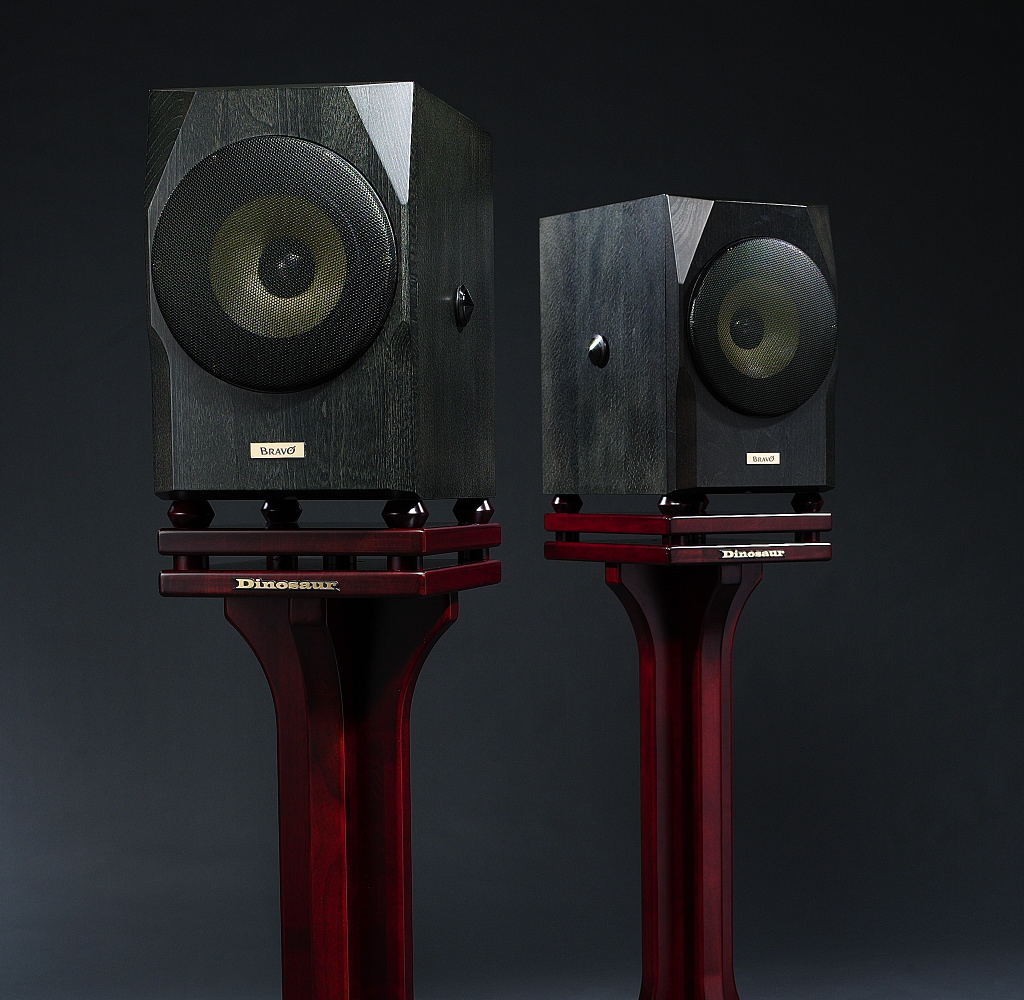
It’s actually rather difficult to find an approach when discussing Bravo! speakers’ structure since they only have a single body, so we might as well start talking about their origin. Kiuchi, in his spare time, tunes some speakers manufactured by certain companies, and one of them is Gradient based in Finland. What kind of company is Gradient? A long time ago, Gradient made a famous product – a subwoofer for Quad ESL-63 static speakers. Gradient soon found out that selling subwoofers wasn’t very rewarding, thus they started making speakers as well. Among the Gradient speakers that Kiuchi tuned, there was a line-up of small speakers called “Prelude,” whose coaxial single-body designed greatly impressed Kiuchi. Therefore, he modified the design and asked Gradient to manufacture Bravo! speakers. Having a nationality of Japan, Bravo! was actually born in Finland. Isn’t this little thing “international” enough?
Special Edition Available
Many of you may wonder: Why bother buying Bravo!? Why not just buy Gradient Prelude since the structure is all the same? Wrong if you think so! Except both being single-body and box-shaped units, Bravo! and Prelude are entirely two different things. In fact, their boxes are different. The front board of Bravo! is hardwood rather than MDF, and the upper and bottom corners of the front board were cut to reduce diffraction. Why use hardwood? Kiuchi believes that hardwood is the best material for sound. “A piano or a violin is not necessarily very big, but the sound it generates spreads through out an entire hall and can be heard clearly. Speakers should also be able to do the same. Have you seen any piano, violin, or guitar made of MDF? No, and that’s because real wood is the best material. Most companies use MDF to make speakers simply because it is easier to work on. Then, why is hardwood only used on the front board of Bravo! instead of the entire body? This is because the processing of real wood is difficult, and the cost of the speakers would probably get too high for anyone to afford. If you look at the front board of Bravo! carefully, you would see that it’s composed of several pieces of wood rather than a single, complete piece.
What are the differences between Bravo! and Prelude besides the front board? Bravo! uses different speaker terminals – it does not only use high-end WBT terminals but also contains an engraved metal plate. The crossover is also specially tuned, and the internal wiring is made by Harmonix for certain.
Appearance of Bravo! Special Edition
Using only a small coaxial, single-body, enclosed sound box made by SEAS, Bravo! has become one of the small speakers that have simple structures and best match with the “point source” theory. The borders of the front board of Bravo! were shaven, and the grill is composed of special metallic nets that cover the unit body’s external frame, showing Kiuchi’s belief of “diffraction” being an important factor that has ill effects on the quality of sound. The Bravo! we listened to was the Special Edition which did not only have special material affixed to the cone for tuning purposes but also cone shaped devices on the two sides of the box.
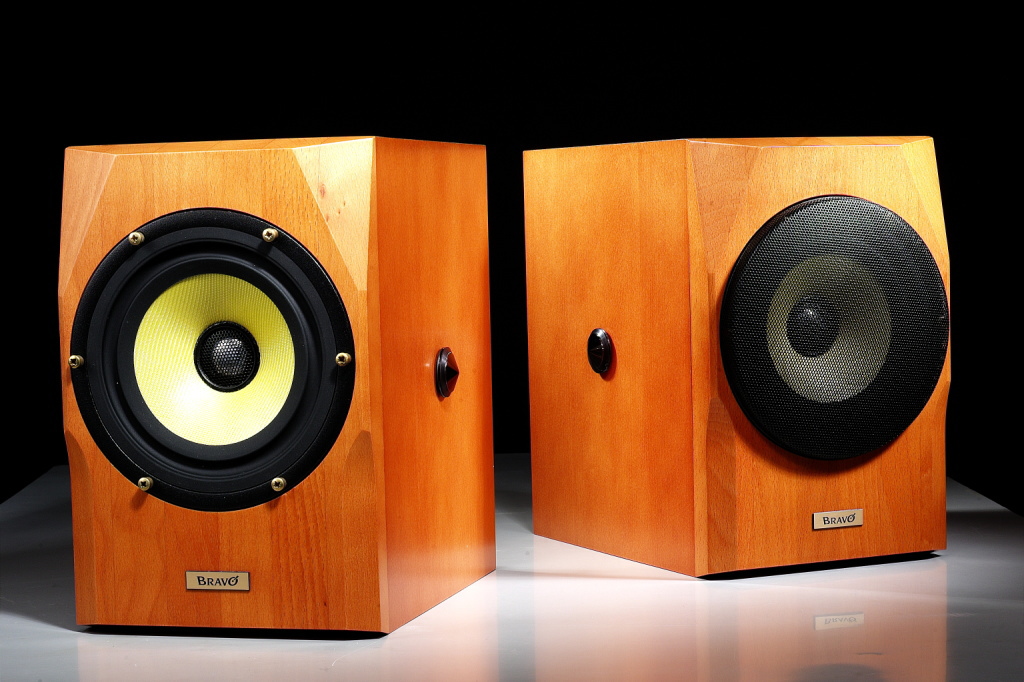
Audio Facts
Three-point or Four-point Support?
What kind of support should be used for audio equipments? Many companies choose 3-point supports since three points form a plane. Theoretically, using only three points to contact the supporting surface would be the steadiest form of support – much like the pyramids being the most stable structures in the world. The products of Harmonix which specialize in tuning, however, all use 4-point supports. Doesn’t Kiuchi understand the simple fact that “3 points form a plane?” See what Kiuchi has to say about using 4-point support: Naturally, 3-point support is, in theory, the most stable form of contact. However, do note that when you use three points to support an equipment, the various points at the bottom of the equipment (machines or speakers) would endure different amount of stress since the bottom is rectangular. Unequaled amount of stress would mean different amount of vibration at various locations, thus the entire unit is not in a stable condition. Of course, if the equipment or speaker is triangular, the 3-point support would be the best method. However, since most equipments or speakers are rectangular, using 4-point supports would provide most stability. Both theories certainly are persuasive in their own right, thus I recommend fellow audiophiles to get empirical and find out the best method!
Appearance of Dinosaur
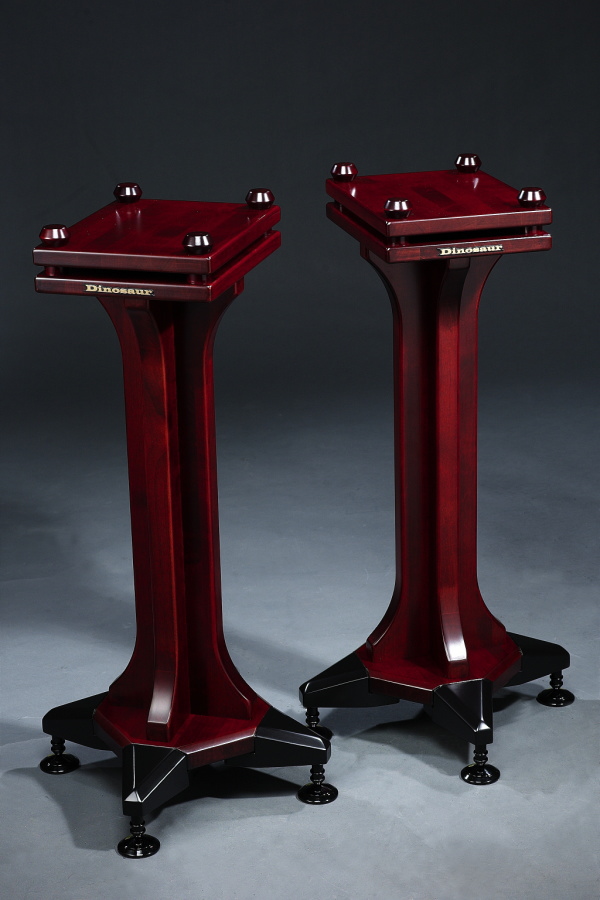 “Dinosaur” earned its name because of its unique shape that is similar to a dinosaur’s leg. The four extending “claws” are made of metal and are at a distance above ground. Two boxes of RF-909X cone-shaped cushions are also included. These cushions aren’t cheap, thus taking the price of Dinosaur to a higher notch. The design of the deck that supports the speaker is rather complicated; besides two layers of real wood decks, there are four wood cushions on top of it. The height of the wood cushions can be adjusted to provide maximum stability for the speaker sitting above. Not surprisingly, the size of Dinosaur’s top plate is a perfect match for Bravo!. The center pillar of Dinosaur is made of two pieces of intertwined wood, which is completely different from ordinary speaker stands that are made of metal and boast “stability.” The spirit of Dinosaur is “to allow any amount of vibration!”
“Dinosaur” earned its name because of its unique shape that is similar to a dinosaur’s leg. The four extending “claws” are made of metal and are at a distance above ground. Two boxes of RF-909X cone-shaped cushions are also included. These cushions aren’t cheap, thus taking the price of Dinosaur to a higher notch. The design of the deck that supports the speaker is rather complicated; besides two layers of real wood decks, there are four wood cushions on top of it. The height of the wood cushions can be adjusted to provide maximum stability for the speaker sitting above. Not surprisingly, the size of Dinosaur’s top plate is a perfect match for Bravo!. The center pillar of Dinosaur is made of two pieces of intertwined wood, which is completely different from ordinary speaker stands that are made of metal and boast “stability.” The spirit of Dinosaur is “to allow any amount of vibration!”
Although Bravo! doesn’t take up too much space, it certainly feels quite heavy when you lift it. Its quality certainly meets the kind of standards that are commonly expected in high-end devices. The Bravo! speakers I saw were different from the ones I saw on the photos: several pieces of black, gum-shaped material were stick onto the box in a radiate manner, and cone-shaped devices were seen at the two sides of the speaker which were used for vibration control. I originally thought this was a prototype made by Kiuchi, but the distributor informed me, right before I was about to write the review, that this pair was the Special Edition which came with some variations and a different price tag. Exactly what are the differences between the Special Edition and the ordinary edition? As usual, Kiuchi didn’t comment on this.
Sufficient for Most Kinds of Music
Since the Bravo! Special Edition stayed in my home for a significant length of time, they had moved along with me to a new house. Therefore, my experience with them took place in two separate locations. The equipments connected to these speakers include: Digital signal source is Slim Devices Transporter that does not only play uncompressed computer sound files but also hooks up to a DVD player that plays 96 kHz/ 24 bit DAD software. The analog source is the entire set of Roksan combination that includes Xerxes .20 turn table, Artemiz arm, and Shiraz head. The head amplifier is ASR Basis Mini. The pre-amp is Ayre K-5xe, and the post-amp is McCormack DNA-1 Deluxe Edition. The speakers for comparison are B&W Silver Signature SS25 and Harbeth Monitor 40.
I didn’t hold too much expectation for Bravo! Special Edition at the beginning. Why not? According to their specifications which I dug up on the Internet, the frequency response of Bravo! was supposed to be 80-20kHz, and it is -2.5dB. What about the low frequency extension at -6dB? It only goes as far as 55Hz. Common sense tells me this kind of speaker alone will never be sufficient! However, when I placed Bravo! Special Edition on the B&W SS25 stone-made stands and turned on the sound, I instantly realized a sound system certainly cannot be judged by its specs. The music expressed by Bravo! Special Edition has a rich, concentrated, yet clean and spacious charisma. When listening to most types of music, you would never feel any insufficiency. Don’t assume the “most types of music” I talk about here are simple pop-music, chamber music, or jazz – I am also talking about symphonies!
Excellent for Small Space
Of course, my sound room isn’t very big. It was about 16.5 square meters before and 21.5 square meters after I moved (with concrete walls at all sides). On its website, Combak mentions that Bravo! is very suitable for spaces in Asia that have concrete walls or stone-walled spaces in Europe as the low-frequency of these speakers are enhanced in a natural way when placed near hard surfaces, resulting in richer sounds. I also believe that the low-frequency of Bravo! doesn’t sound as conservative as its specs, and this is probably due to its clean and precise reproduction of low-frequency sounds. When listening to Telarc’s live performance of “Superbass 2,” the image, texture, and tension of the three cellos felt like flowing outside the speakers. With the sound of a bow being drawn against the strings, the entire performance was just too fascinating! By comparison, the two speakers I used for comparison purposes lacked the clarity and transparency that Bravo! offered at mid or low frequencies. After listening to Bravo!, I am guessing that you would also sense certain degrees of “muddiness” on any other speakers that you listen to.

Besides low frequencies, the clear sound that Bravo! produces is rather quite significant in all frequencies. I believe this is thanks to its excellent performance in the transient state as the sound doesn’t get “stuck” inside the box. Rather, it is naturally, smoothly, and quickly (but not being forcefully) expressed from the single-unit sound box. Some readers may find it difficult to feel the differences in terms of transient sound since not many products offer outstanding performance in this regard. Bravo! Special Edition actually worked like static speakers that accurately reproduce rich sounds.
Bring On the Dinosaur
The first time I saw Dinosaur speaker stands was when Kiuchi came to Taiwan last time. I have to be honest with you: when I found out the price of this speaker stand, I was deeply shocked. More than ten years ago, when Sonus Faber and Ensemble started selling fancy speaker stands for more than NT$ 20,000, we were already cursing as we gave them our hard-earned money. Now, Dinosaur speaker stands actually charge the same amount as Bravo! speakers do? What are they thinking? Alright, I would assume a speaker stand with a 6-digit price tag being quite heavy. But no! Dinosaur is lighter than any other speaker stands I have ever seen, with each stand weighing less than 5 kg! Also, such expensive speaker stands actually require DIY assembly like IKEA furniture does. This just makes me seriously question the value of these speakers.
However, I was then TRULY shocked when I listened to the sound coming out of Bravo! speakers that were placed on Dinosaur stands. “What happened,” you might wonder. The Bravo! speakers on Dinosaur were like speakers on steroids – they instantly disperse more message! “Disperse?” That’s right! The amount of additional message was like the bubbles in a glass of champagne that go all the way up from the bottom and break into thin air, transferring all the wonderful aroma upwards. This is exactly what Dinosaur did: filling the entire room with “acoustic aroma.” Some people might say the speakers add rendering effects. However, those who have been to live performances in concert halls would surely know that the sounds generated by instruments naturally disperse through out the space, allowing the audience to experience the quality of the instruments. Bravo! on Dinosaur stands indeed put me in a live music hall where the aroma of musical instruments fulfilled the entire atmosphere.
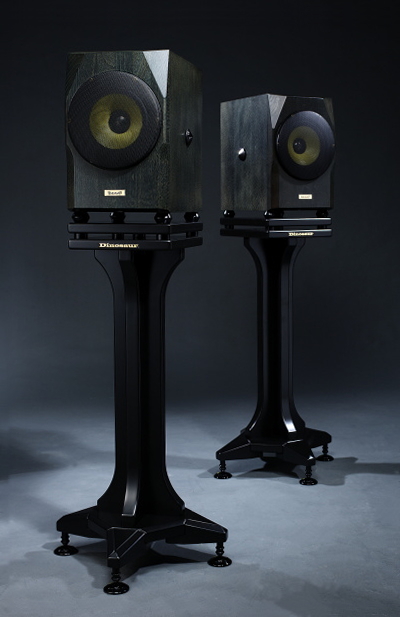
Full Frequency Energy Expression
Then, is Dinosaur a “mid-high frequency enhancer?” No. Dinosaur’s effect doesn’t only limit to mid/ high frequencies but rather covers the entire frequencies. Mid/ high frequencies were only the first area that I took notice of; as I listened to the speakers further, I started to discover that Dinosaur was able to bring out excellent low-frequency performances out of Bravo! that I was unable to hear earlier. The sound image did not only get richer, but was also full of flexible and vivid tension. I wasn’t able to put other small speakers on Dinosaur (the 70-cm tall stands were too tall for most speakers), but Kiuchi claims that Dinosaur is the “essential” equipment for all small speakers. After experiencing the wonder of Dinosaur, I asked Kiuchi why I had never experienced such amazing speaker stands before. His reply was “all other speaker stands are just built wrong.”
If I have to answer you what the charisma of the combination of Bravo! and Dinosaur was, I would say the most amazing thing was that the sound generated from such a simple single-body unit was so rich and full and…(and I can’t believe I said this) so complete. Whenever I listened to the performance given by this combination, I was amazed by the world of sound as something so simple can deliver something so complex. It’s true that Bravo! Special Edition and Dinosaur cannot give you unlimited dynamics and lateral extensions, but they are indeed perfect in their own right. If you wish to create your own perfection in a small space, try Bravo! It may very well be the speaker that can reach this kind of perfection!
Bravo! Special Edition’s Betrayal
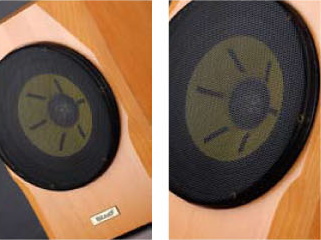 Although being a single unit, it is still a coaxial single unit, thus there is still a crossover inside of it. There are also connecting terminals at the back of Bravo! – they are even high-end WBT products. What is special is that that are engravings, similar to the f-holes on a violin, on the metal plate next to the terminals. If you are familiar with Harmonix’ products, you would know that such engravings are also found in their sound-tuning CD patches.
Although being a single unit, it is still a coaxial single unit, thus there is still a crossover inside of it. There are also connecting terminals at the back of Bravo! – they are even high-end WBT products. What is special is that that are engravings, similar to the f-holes on a violin, on the metal plate next to the terminals. If you are familiar with Harmonix’ products, you would know that such engravings are also found in their sound-tuning CD patches.
[close]